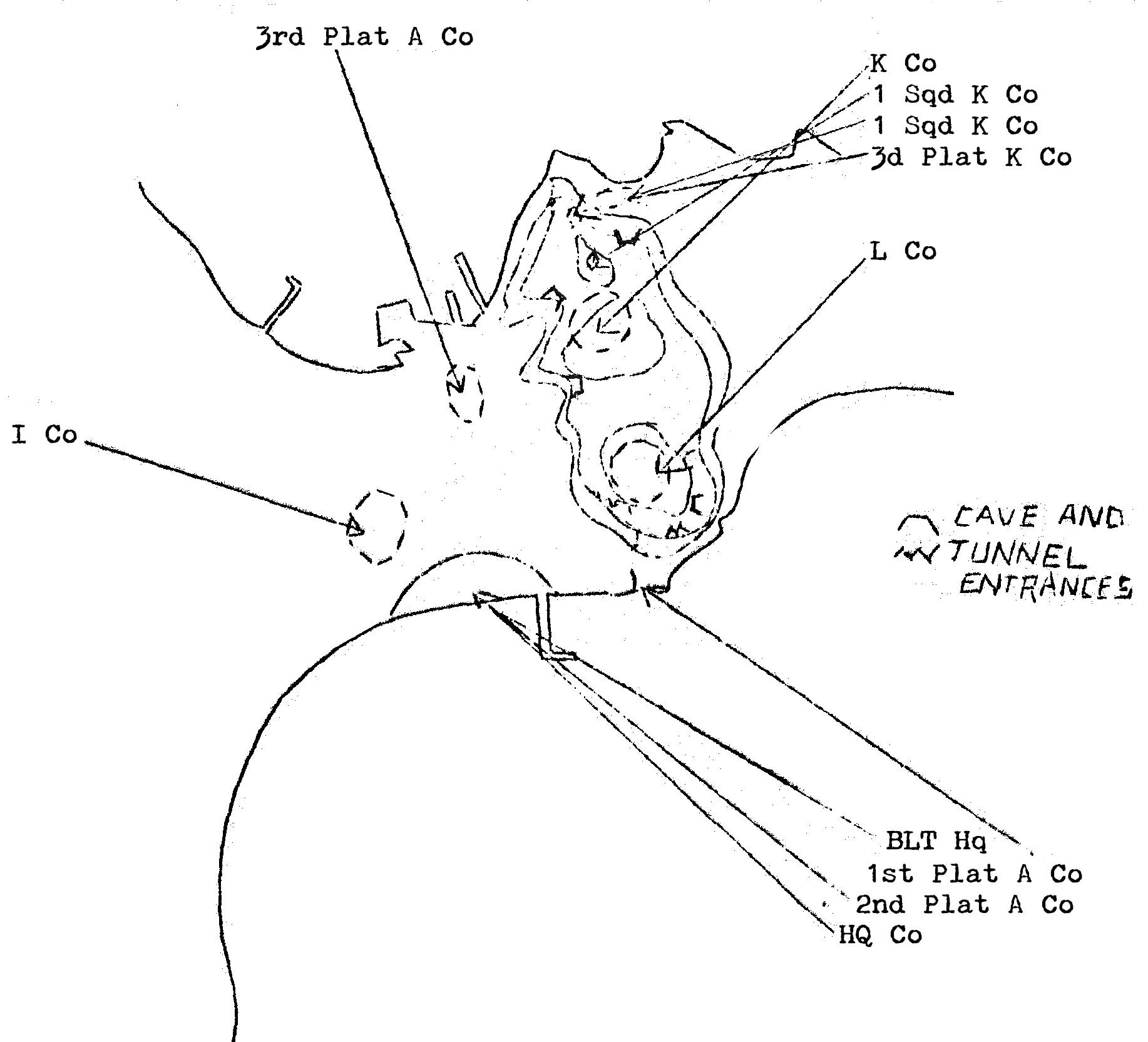|
At 1400, 2 platoons of "A" - the first and second - were recalled to the
beach to assist in unloading procedures. The platoons had to cross a
piece of low, open ground on which lay a pulverized (missing text)
some 500 yards northwest, in the vicinity of a well revetted building
which had been used as an ice plant. Several casualties were sustained
by the platoons but they got across. During the rest of the afternoon,
still under crossfire on the beach, they unloaded the boats in SAN JOSE
BAY. Just before dark, the first platoon was sent out to set up a road
block on the south and of MALINTA HILL, where the road snakes like a
narrow shelf above the bay.
The whole afternoon had boon swathed in peculiar quiet for "K" company,
atop northern MALINTA HILL. A brace of squads were sent out to a brace
of knolls to effect a more or less integrated line, extending from the
company perimeter on the southwest to 3rd platoon on the northeast.
There was nothing to do but sit tight. A similar situation existed on
the southern half of the tunnel-ridden hill. "L" company performed the
'holding' part of its mission.
At first, it appeared that "A" company's first platoon - out on its
roadblock - was going to experience the warmest night. Scarcely had the
fat blue flies that swarmed over the island begun to retard their
buzzing, when the platoon, constantly under fire, saw a great section of
the cliff above them lurch into the night with a deafening roar. The
Japs had mined it - filled it so full of explosive charge, that when the
fuse was touched off and the charge blew, it sent the rock designed to
fall across the road, blocking it, over the heads of the troops below,
and on out into the bay. Only impotent chips and dust fell on the road
and the "A" company men.
During the night of February 16th, the second platoon of "A" company,
protecting the beach with elements of "H", killed 23 Japs who attempted
to swim around their position from SAN JOSE POINT.
The night's really bloody paragraphs wore written where the day had left
blank pages - on the north of MALINTA HILL by "K" company.
Just before midnight, the sudden shouts of men, the piercing rataplan of
gunfire told of a fight on the knolls below. The line to 3rd platoon
went out. Mortar shells burst in the company position.
One of the men from the first squad outpost north of the company
struggled up the hillside, carrying a comrade with a mangled leg,
helping another whose hands dripped blood. A moment later, two men from
the outpost nearest 3d platoon clambered in. Third platoon and both
squad outposts had been suddenly attacked by an enemy party trying to
drive a wedge southward to the dense little SAN JOSE beach. Third
platoon had driven them off. The two squad outposts had been all but
wiped out. Of both, those 5 and one other were all that ever got back.
Before any attempt could be made to rescue the still-living wounded of
the outposts who'd been left out front, the Japs came. Impossible though
it seemed, they came straight up the almost perpendicular northwest side
of the "K" Company hill. They camp with all the fury of the damned - in
the epitome of the ‘Banzai’ tradition. Their weapons were everything
from American rifles to spears. The cliff they climbed was so steep that
those who were hit at the top fell straight into the faces of their
comrades farther down - straight to the bottom of tho gorge below.
It was a major midnight two-wave counterattack. It got to within 10 feet
of the "K" company perimeter. "K" turned it back.
The following day, "K" company's commander dispatched patrols to bring
back the dead and wounded from the squad outposts the Japs had swamped.
Devastating fire turned them back. Then the company commander himself
took a patrol. He wanted to bring his wounded in. He'd gone but a few
yards, at the head of his patrol, when a Jap rifle cracked and he fell
out of view, just over a little hump in the ground. His men viciously
returned the enemy fire - crawled to within inches of him, tried again
to bring the officer back. Three grenades exploded almost on top of him.
The Japs kept his body covered by fire. The men had to leave him there.
The company could only see to count 35 Jap bodies in front of their
positions and in the gullies below them.
SITUATION CLOSE OF FEBRUARY 16
 |

